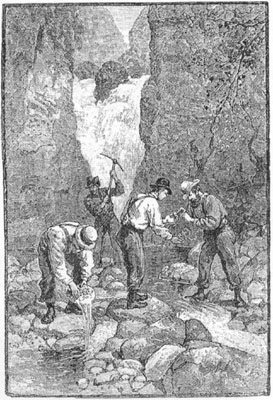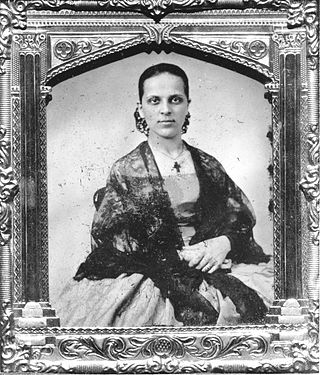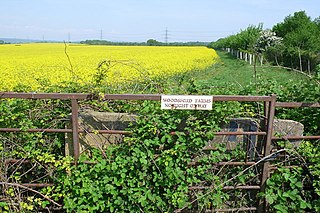
The California gold rush (1848–1855) was a gold rush that began on January 24, 1848, when gold was found by James W. Marshall at Sutter's Mill in Coloma, California. The news of gold brought approximately 300,000 people to California from the rest of the United States and abroad. The sudden influx of gold into the money supply reinvigorated the American economy; the sudden population increase allowed California to go rapidly to statehood in the Compromise of 1850. The Gold Rush had severe effects on Native Californians and accelerated the Native American population's decline from disease, starvation, and the California genocide.

A gold rush or gold fever is a discovery of gold—sometimes accompanied by other precious metals and rare-earth minerals—that brings an onrush of miners seeking their fortune. Major gold rushes took place in the 19th century in Australia, Greece, New Zealand, Brazil, Chile, South Africa, the United States, and Canada while smaller gold rushes took place elsewhere.

The General Mining Act of 1872 is a United States federal law that authorizes and governs prospecting and mining for economic minerals, such as gold, platinum, and silver, on federal public lands. This law, approved on May 10, 1872, codified the informal system of acquiring and protecting mining claims on public land, formed by prospectors in California and Nevada from the late 1840s through the 1860s, such as during the California Gold Rush. All citizens of the United States of America 18 years or older have the right under the 1872 mining law to locate a lode or placer (gravel) mining claim on federal lands open to mineral entry. These claims may be located once a discovery of a locatable mineral is made. Locatable minerals include but are not limited to platinum, gold, silver, copper, lead, zinc, uranium and tungsten.

A land claim is defined as "the pursuit of recognized territorial ownership by a group or individual". The phrase is usually only used with respect to disputed or unresolved land claims. Some types of land claims include aboriginal land claims, Antarctic land claims, and post-colonial land claims.

Auraria is a ghost town in Lumpkin County, Georgia, United States, southwest of Dahlonega. Its name derives from aurum, the Latin word for gold. In its early days, it was also known variously as Dean, Deans, Nuckollsville, and Scuffle Town.
In the American legal system, prior appropriation water rights is the doctrine that the first person to take a quantity of water from a water source for "beneficial use" has the right to continue to use that quantity of water for that purpose. Subsequent users can take the remaining water for their own use if they do not impinge on the rights of previous users. The doctrine is sometimes summarized, "first in time, first in right".

Gold mining is the extraction of gold by mining.

State Route 49 is a north–south state highway in the U.S. state of California that passes through many historic mining communities of the 1849 California gold rush and it is known as the Golden Chain Highway. The highway's creation was lobbied by the Mother Lode Highway Association, a group of locals and historians seeking a single highway to connect many relevant locations along the Gold Rush to honor the 49ers. One of the bridges along SR 49 is named for the leader of the association, Archie Stevenot.

The California Department of Water Resources (DWR) is part of the California Natural Resources Agency and is responsible for the management and regulation of the State of California's water usage. The department was created in 1956 by Governor Goodwin Knight following severe flooding across Northern California in 1955, where they combined the Division of Water Resources of the Department of Public Works with the State Engineer's Office, the Water Project Authority, and the State Water Resources Board. It is headquartered in Sacramento.
The history of California can be divided into the Native American period, the European exploration period (1542–1769), the Spanish colonial period (1769–1821), the Mexican period (1821–1848), and United States statehood. California was one of the most culturally and linguistically diverse areas in pre-Columbian North America. After contact with Spanish explorers, many of the Native Americans died from foreign diseases. Finally, in the 19th century there was a genocide by United States government and private citizens, which is known as the California genocide.

The Georgia Gold Rush was the second significant gold rush in the United States and the first in Georgia, and overshadowed the previous rush in North Carolina. It started in 1829 in present-day Lumpkin County near the county seat, Dahlonega, and soon spread through the North Georgia mountains, following the Georgia Gold Belt. By the early 1840s, gold became difficult to find. Many Georgia miners moved west when gold was found in the Sierra Nevada in 1848, starting the California Gold Rush. Since the 16th century, American Indians in Georgia told European explorers that the small amounts of gold which they possessed came from mountains of the interior. Some poorly documented accounts exist of Spanish or French mining gold in North Georgia between 1560 and 1690, but they are based on supposition and on rumors passed on by Indians. In summing up known sources, W.S. Yeates observed: "Many of these accounts and traditions seem to be quite plausible. Nevertheless, it is hardly probable that the Spaniards would have abandoned mines which were afterwards found to be quite profitable, as those in North Georgia."

Peter Hardeman Burnett was an American politician who served as the first elected Governor of California from December 20, 1849, to January 9, 1851. Burnett was elected Governor almost one year before California's admission to the Union as the 31st state in September 1850.
Edmond Edward Wysinger was an African American pioneer in California, arriving around October 1849 at the beginning of the California Gold Rush.

Women in the California Gold Rush, which began in Northern California in 1848, initially included Spanish descendants, or Californios, who already lived in California, Native American women, and rapidly arriving immigrant women from all over the world. At first, the numbers of immigrant women were scarce, but they contributed to their community nonetheless. Some of the first people in the mining fields were wives and families who were already in California. A few settler women and children and the few men who did not leave their family worked right alongside the men but most men who arrived left their wives and families home. The number of women in California changed very quickly as the rich gold strikes and lack of women created strong pressures in the new Gold Rush communities to restore sex balance. As travel arrangements improved and were made easier and more predictable the number of women coming to California rapidly increased. Most women probably came by way of Panama as this was one of the fastest trips and one of the most reliable—although expensive in 1850--$400–$600/person one-way. Passage via Panama became much more predictable after the paddle wheel steam ship lines were up and running by late 1849. In Ireland, the Great Famine was a period of mass starvation, disease and emigration between 1845 and 1852 that drove many desperate women to the United States and on to California.
A miners' court was a type of quasi-judicial court common in the American Old West that summoned a subset of the miners in a district when a dispute arose.
Mining in the United States has been active since the beginning of colonial times, but became a major industry in the 19th century with a number of new mineral discoveries causing a series of mining rushes. In 2015, the value of coal, metals, and industrial minerals mined in the United States was US$109.6 billion. 158,000 workers were directly employed by the mining industry.

In the context of thoroughfares, a right of way is a legal term used for the right to cross lands belonging to another or others. In some cases this right is legally defined as an easement by prescription or in more general legislation such as the Countryside and Rights of Way Act 2000 in England and Wales. The right may be limited to pedestrians only, or extended to pedestrians, horse-riders and cyclists.

Josefa Segovia, also known as Juanita or Josefa Loaiza, was a Mexican-American woman who was executed by hanging in Downieville, California, on July 5, 1851. She was found guilty of murdering a local miner, Frederick Cannon. She is known to be the first and only woman to be hanged in California.

The case of Woodruff v. North Bloomfield Gravel Mining Company was a lawsuit brought to California courts in 1882 where a group of local farmers sued North Bloomfield Mining and Gravel Company over damages caused to farmland in the Central Valley. The farmers who brought the suit claimed that the company's hydraulic mining operations resulted in the disposal of excess sediment, debris, and chemicals in local rivers. Prosecutors argued that the debris raised river beds and restricted flow in the rivers leading to heavy man-made flooding. In the years prior, flooding of debris and chemicals had destroyed a large portion of the valley's agriculture.
The California Gold Rush (1848-1855) was a period of American history in which the most amount of gold seen at the time was discovered. The initial discovery of gold in America in 1848 attracted many immigrants who were intent on the opportunity and potential wealth that came with gold mining. Typically the people that came to America were from the British Isles and the Asia-Pacific region. These foreign miners initially worked in small-scale operations using placer deposits found along streams. As mining technology developed over time and placer deposits slowly depleted mining became corporate, paving the way for quartz mining to take the forefront of Gold production.













